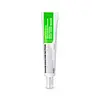What's inside
What's inside
 Key Ingredients
Key Ingredients

 Benefits
Benefits

 Concerns
Concerns

 Ingredients Side-by-side
Ingredients Side-by-side

Centella Asiatica Extract
CleansingWater
Skin ConditioningHydrogenated Poly(C6-14 Olefin)
EmollientGlycerin
HumectantCetyl Ethylhexanoate
EmollientCaprylic/Capric Triglyceride
MaskingCetyl Alcohol
Emollient1,2-Hexanediol
Skin ConditioningButylene Glycol
HumectantDipropylene Glycol
HumectantMethyl Trimethicone
Skin ConditioningPentaerythrityl Tetraisostearate
EmollientDipentaerythrityl Hexa C5-9 Acid Esters
Skin ConditioningPotassium Cetyl Phosphate
EmulsifyingSodium Hyaluronate
HumectantButyrospermum Parkii Butter
Skin ConditioningPanthenol
Skin ConditioningPalmitoyl Dipeptide-10
Skin ConditioningPalmitoyl Tripeptide-1
Skin ConditioningPalmitoyl Tetrapeptide-7
Skin ConditioningPalmitoyl Hexapeptide-12
Skin ConditioningPolyglyceryl-2 Stearate
EmulsifyingAsiaticoside
AntioxidantAsiatic Acid
Skin ConditioningMadecassic Acid
Skin ConditioningStearic Acid
CleansingGlyceryl Stearate
EmollientStearyl Alcohol
EmollientMacadamia Ternifolia Seed Oil
EmollientLimnanthes Alba Seed Oil
Skin ConditioningArgania Spinosa Kernel Oil
EmollientCaprylyl Glycol
EmollientCetearyl Olivate
Sorbitan Olivate
EmulsifyingCamellia Sinensis Extract
AntioxidantPancratium Maritimum Extract
BleachingAcetyl Glucosamine
Skin ConditioningCeramide NP
Skin ConditioningAcrylates/C10-30 Alkyl Acrylate Crosspolymer
Emulsion StabilisingAdenosine
Skin ConditioningTromethamine
BufferingCarbomer
Emulsion StabilisingDisodium EDTA
Lavandula Angustifolia Oil
MaskingCitrus Aurantium Bergamia Fruit Oil
MaskingCentella Asiatica Extract, Water, Hydrogenated Poly(C6-14 Olefin), Glycerin, Cetyl Ethylhexanoate, Caprylic/Capric Triglyceride, Cetyl Alcohol, 1,2-Hexanediol, Butylene Glycol, Dipropylene Glycol, Methyl Trimethicone, Pentaerythrityl Tetraisostearate, Dipentaerythrityl Hexa C5-9 Acid Esters, Potassium Cetyl Phosphate, Sodium Hyaluronate, Butyrospermum Parkii Butter, Panthenol, Palmitoyl Dipeptide-10, Palmitoyl Tripeptide-1, Palmitoyl Tetrapeptide-7, Palmitoyl Hexapeptide-12, Polyglyceryl-2 Stearate, Asiaticoside, Asiatic Acid, Madecassic Acid, Stearic Acid, Glyceryl Stearate, Stearyl Alcohol, Macadamia Ternifolia Seed Oil, Limnanthes Alba Seed Oil, Argania Spinosa Kernel Oil, Caprylyl Glycol, Cetearyl Olivate, Sorbitan Olivate, Camellia Sinensis Extract, Pancratium Maritimum Extract, Acetyl Glucosamine, Ceramide NP, Acrylates/C10-30 Alkyl Acrylate Crosspolymer, Adenosine, Tromethamine, Carbomer, Disodium EDTA, Lavandula Angustifolia Oil, Citrus Aurantium Bergamia Fruit Oil
Tranexamic Acid
AstringentCetyl Phosphate
EmulsifyingTocopherol
AntioxidantHydrolyzed Hyaluronic Acid
HumectantSodium Hyaluronate
HumectantDipropylene Glycol
HumectantButylene Glycol
HumectantGlycerin
HumectantHydrolyzed Phospholipids
Skin ConditioningPEG-8
HumectantPei-30
PEG-20 Laurate
EmulsifyingSorbitan Oleate
EmulsifyingStyrene/Ma Copolymer
Emulsion StabilisingCitric Acid
BufferingSodium Paraben
Preservative
 Reviews
Reviews

Ingredients Explained
These ingredients are found in both products.
Ingredients higher up in an ingredient list are typically present in a larger amount.
Butylene Glycol (or BG) is used within cosmetic products for a few different reasons:
Overall, Butylene Glycol is a safe and well-rounded ingredient that works well with other ingredients.
Though this ingredient works well with most skin types, some people with sensitive skin may experience a reaction such as allergic rashes, closed comedones, or itchiness.
Learn more about Butylene GlycolDipropylene Glycol is a synthetically created humectant, stabilizer, and solvent.
This ingredient helps:
Dipropylene glycol is technically an alcohol, but it belongs to the glycol family (often considered part of the ‘good’ alcohols). This means it is hydrating and gentle on skin unlike drying solvent alcohols like denatured alcohol.
As a masking agent, Dipropylene Glycol can be used to cover the smell of other ingredients. However, it does not have a scent.
Studies show Dipropylene Glycol is considered safe to use in skincare.
Learn more about Dipropylene GlycolGlycerin is already naturally found in your skin. It helps moisturize and protect your skin.
A study from 2016 found glycerin to be more effective as a humectant than AHAs and hyaluronic acid.
As a humectant, it helps the skin stay hydrated by pulling moisture to your skin. The low molecular weight of glycerin allows it to pull moisture into the deeper layers of your skin.
Hydrated skin improves your skin barrier; Your skin barrier helps protect against irritants and bacteria.
Glycerin has also been found to have antimicrobial and antiviral properties. Due to these properties, glycerin is often used in wound and burn treatments.
In cosmetics, glycerin is usually derived from plants such as soybean or palm. However, it can also be sourced from animals, such as tallow or animal fat.
This ingredient is organic, colorless, odorless, and non-toxic.
Glycerin is the name for this ingredient in American English. British English uses Glycerol/Glycerine.
Learn more about GlycerinSodium Hyaluronate is hyaluronic acid's salt form. It is commonly derived from the sodium salt of hyaluronic acid.
Like hyaluronic acid, it is great at holding water and acts as a humectant. This makes it a great skin hydrating ingredient.
Sodium Hyaluronate is naturally occurring in our bodies and is mostly found in eye fluid and joints.
These are some other common types of Hyaluronic Acid:
Learn more about Sodium Hyaluronate